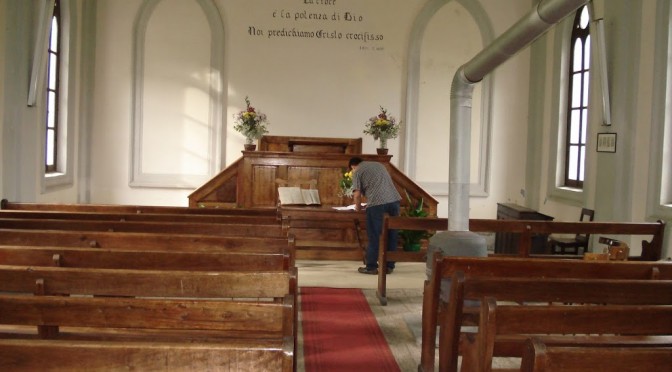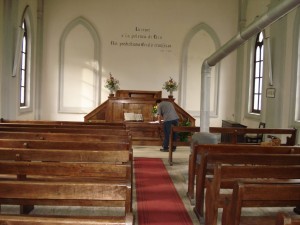This church should feel very familiar to many people in the URC; the plain wood, the clear glass the white washed walls, and the communion table at the centre in the front with a pulpit above and the Bible open. If it was not for the red carpet you’d almost be sure you were in a URC.
However look closer and you see the heating systems a bit different to what we are used and there is writing on the wall which is not in English. You are actually looking at a Waldensian Church in the Alps in Italy. If you click on the link it should take you to a webpage that tells you more about the Waldensians. However it is enough to say they are the Italian branch of the Reformed family of churches.
Some of the more ornate traditions within the faith look at us and see cheapness, they are of course wrong. The chairs and furnishings may be plain wood but they high quality oak, the windows may let through plenty of light but if you look carefully you see they are not plain glass, the drape across the door may not be spectacularly embroidered but is of heaviest quality velvet. This is not cheapness but a deliberate aesthetic and the quality of the goods use belies their plainness.
I have heard a number of theories, some suggest it is iconoclasm, if that is the case it is to Zwingli in Zurich it comes from not Calvin in Geneva, for whom candles and such were irrelevancy. It might have been a reaction against those who would enforce ritual upon us that we chose to be plain just to contrary, or perhaps as in many places the early churches were barns we have chosen to remember those times by keeping as similar sort of aesthetic. I suspect it is kept today largely because to us it feels right.
In what is often a light calm space comes a specific arrangement of items. At the focus is the communion table and not the cross (empty or otherwise) which puts our action in the context of a God who choose to connect with us. In quite a few churches although the communion table is the focal point the congregation is arranged so that we see each other emphasising the communal nature of worship. The lectern and pulpit are also prominent at the front, sometimes above the communion table, sometimes to the side to remind us visually of the importance of the Word. The lack of paintings and other artwork has not made the space lacking symbols but one where distractions are eliminated to allow the central symbols a more clear space in which to speak. It encourages us to pay attention to these things.


